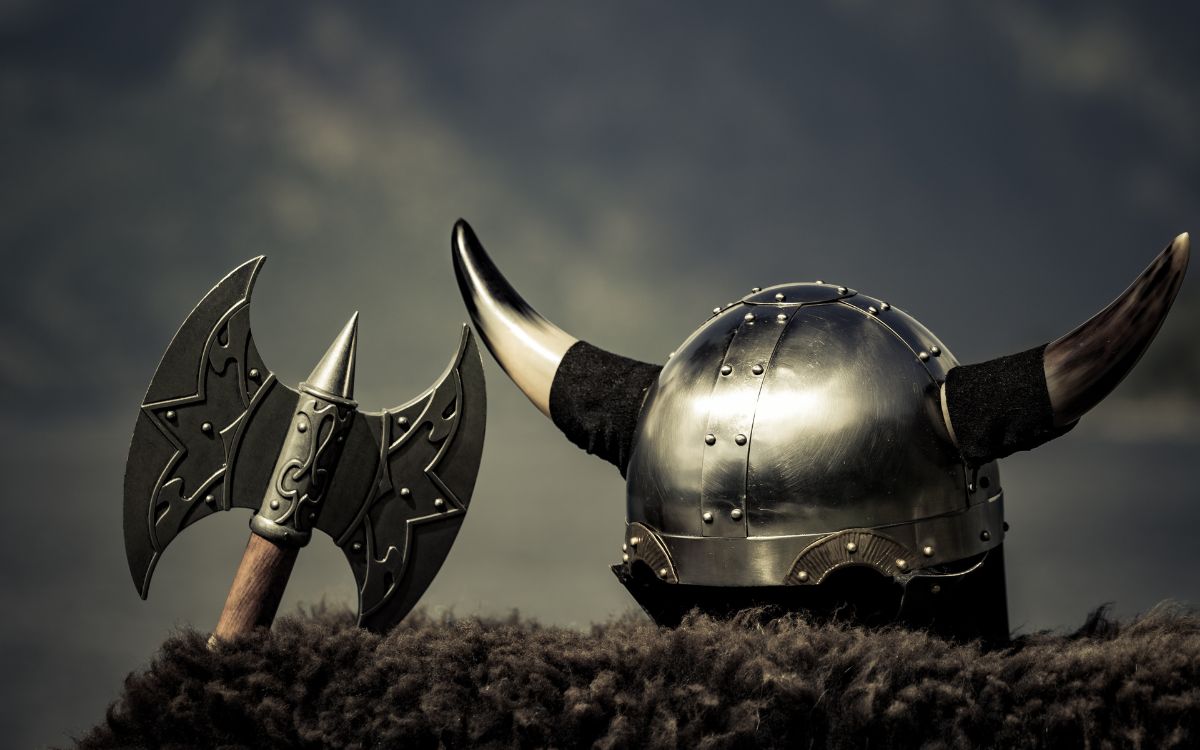Old Norse, as it is known today, was the language of the Vikings. Today, it is considered one of the many dead languages in the language family.
As the Vikings invaded new lands, their language shifted to the languages of those lands, which included areas such as the British Isles, Russia, Greenland, and even some parts of North America. While it’s a dead language, many English words derive from Old Norse.
Many ancient texts, like the Prose Edda and the Poetic Edda, are written in old Norse. Translations of these ancient texts are available, but if you want to squeeze every last drop from these ancient texts, you’ll need some understanding of the language.
Dead languages aren’t impossible to learn if you know where to look. So, let’s dive into the language of the Viking age and how you can pick up a few pointers on learning this forgotten language.
Did Vikings Speak Old Norse?
What we know today as Old Norse was spoken by the Vikings around the 8th century and bled into the medieval period. As Vikings invaded and conquered lands around Northern Europe, their language changed.
As with any language, Old Norse dialects slightly changed when traveling from different regions. Old Norse is a blanket term to describe Old Icelandic, Old Danish, Old Norwegian, and Old Swedish. When someone references Old Norwegian, for instance, they are likely referring to Old Norse.
There were also dialects of Old Norse that were all slightly different. Depending on where you were in Northern Europe, Old East Norse or Old West Norse and Old Gutnish dialects were similar but somewhat different.
Old Gutnish, for instance, was spoken in areas such as the Swedish isle of Gotland and was the precursor to the Gothic language.
The approximate extent of Old Norse and other Germanic languages in the early 10th century.

What’s The Difference Between Proto-Norse And Old Norse?
The prefix proto implies that Proto-Norse came before Old Norse. Proto-Norse was spoken between the second and eighth centuries before Old Norse was eventually developed.
Proto-Norse was written in Younger Futhark, which only utilizes 16 runic letters. It existed almost 1,000 years before Old Norse came to be.
Old Norse that we know today was written using Elder Futhark, composed of 24 runes. As Vikings conquered land in Europe and Christianization took place, much of Old Norse was replaced with Latin and the language of neighboring countries.
To understand the evolution of old Norse, you must first understand its timeline.
- Proto-Norse: 2nd to the 8th century CE
- Old Norse: 8th century – 15th century CE
- Old Norse assimilated with modern languages: 15th century and beyond
Is Old Norse Still Spoken?
No, Old Norse, the way it was used in sagas in the Poetic Edda, is not spoken today.
However, there are echoes of this ancient language still found in modern Icelandic languages. It’s so similar that modern Icelandic speakers can read and translate much of old nordic texts.
Think of Old Norse and Modern Icelandic languages similar to English and Old English. English speakers can read and understand the writing of someone that wrote in Old English in England, like William Shakespeare. While some Old English idioms may require a little extra investigation to track down their meaning, it’s still something English speakers can decipher and understand.
Icelandic is the next best thing if you want to try and understand some of the Old Norse texts but feel overwhelmed attempting to learn a dead language.
What Are Some Common Words In Old Norse?
Did you know that you use old Norse words daily? While the language is classified as dead in the language family, some words stuck around.
109 of the most common Old Norse words that found their way into our daily language include:
| English | Old Norse | Meaning |
|---|---|---|
| berserk | berserkr | lit. a “bear-shirt” a Viking warrior who entered battle wearing nothing for armor but an animal skin |
| club | klubba | a heavy, blunt weapon |
| gun | gunn | from the female name Gunnhildr: gunn (war) + hildr (battle) |
| ransack | rannsaka | to search a house |
| scathe | skaða | to injure |
| slaughter | slatra | to butcher |
| bug | búkr | an insect within tree trunks |
| bull | boli | |
| reindeer | hreindyri | |
| skate | skata | a kind of fish |
| wing | vængr | |
| bylaw | bylög | village-law |
| heathen | heiðinn | one who inhabits the heath or open country |
| Hel | Hel | Loki’s daughter and ruler of the underworld |
| husband | húsbóndi | hús (house) + bóndi (occupier and tiller of soil) |
| law | lag | |
| litmus | lit-mosi | litr (dye) + mosi (moss) |
| loan | lán | to lend |
| sale | sala | |
| skill | skil | distinction |
| steak | steik | to fry |
| thrall | þræll | slave |
| thrift | þrift | prosperity |
| troll | ||
| saga | ||
| yule | jol | a pagan winter solstice feast |
| dirt | drit | excrement |
| dregs | dregg | sediment |
| mire | myrr | bog |
| muck | myki | cow dung |
| rotten | rotinn | |
| axle | öxull | axis |
| bag | baggin | |
| ball | bǫllr | a round object |
| band | band | rope |
| bulk | bulki | cargo |
| cake | kaka | |
| egg | egg | |
| glove | lofi | the middle of the hand |
| knot | knutr | |
| keel | kjölr | |
| link | hlenkr | |
| loft | lopt | air; sky; upper room |
| mug | mugge | |
| plow, plough | plogr | |
| raft | raptr | log |
| scale (for weighing) | skal | bowl; drinking cup |
| scrap | skrap | |
| seat | sæti | |
| skirt | skyrta | shirt |
| want | vondr | rod |
| window | vindauga | lit. “wind-eye” |
| bark | bǫrkr | |
| bask | baðask | reflexive of baða, “to bathe” |
| billow | bylgja | |
| blunder | blundra | to shut one’s eyes; to stumble about blindly |
| call | kalla | to cry loudly |
| cast | kasta | to throw |
| choose | kjósa | |
| clip | klippa | to cut |
| crawl | krafla | to claw |
| gawk | ga | to heed |
| get | geta | |
| give | gefa | |
| glitter | glitra | |
| haggle | haggen | to chop |
| hit | hitta | to find |
| kindle | kynda | |
| race | rás | to move swiftly |
| raise | reisa | |
| rid | rythja | to clear land |
| run | renna | |
| scare | skirra | |
| scrape | skrapa | |
| snub | snubba | to curse |
| sprint | spretta | to jump up |
| stagger | stakra | to push |
| stain | steina | to paint |
| stammer | stemma | to hinder; to dam up |
| sway | sveigja | to bend; to give way |
| take | taka | |
| seem | sœma | to conform |
| shake | skaka | |
| skip | skopa | |
| thwart | þver | across |
| want | vanta | to lack |
| whirl | hvirfla | to go around |
| whisk | viska | to plait or braid |
| aloft | á + lopt | on + loft; sky; heaven |
| ill | illr | bad |
| loose | lauss | |
| sly | sloegr | |
| scant | skamt | short; lacking |
| ugly | uggligr | dreadful |
| weak | veikr | |
| fellow | felagi | |
| guest | gestr | |
| kid | kið | young goat |
| lad | ladd | young man |
| oaf | alfr | elf |
| freckles | freknur | |
| foot | fótr | |
| girth | gjörð | circumference |
| leg | leggr | |
| skin | skinn | animal hide |
| anger | angr | trouble; affliction |
| awe | agi | terror |
| happy | happ | good luck; fate |
| irk | yrkja | to work |
Until the 11th century, Old Norse was the most common language in much of Northern Europe and surrounding areas. While their language faded as the centuries went on, Anglo-Saxons who immigrated from their lands picked up a few handy Old Norse words and assimilated them into their language.
As Norse faded from Europe, some words found a permanent place in English. Old Norse may be gone, but it is not forgotten.
What Is The Closest Language To The Vikings?
If you are looking for the closest modern language to that of the Vikings, it’s modern Icelandic.
Old Norse and Icelandic are so closely related that you may be able to understand some of the ancient Norse texts!
Is It Possible To Learn Old Norse Today?
It’s possible, but it’s not easy. Learning Old Norse is similar to learning Latin to understand the Latin translation of the Bible. It can be done, but be prepared for an uphill climb.
While it’s difficult, reading through many Old Norse sagas in their ancient tongue is incredibly rewarding.
Since Old Norse is considered a dead language, so it’s not as easy to learn as modern languages. There’s no Old Norse section on Duolingo!
If you are willing, some excellent books can help decipher the ancient Prose Edda to learn even more about Norse mythology first-hand.
The book Viking Language 1: Learn Old Norse, Runes, and Icelandic Sagas by Jesse L. Byock is a great place to start. It helps you understand the structure of old Norse while using the tools learned to decipher some of the more popular Norse sagas. It’s insightful and helpful and allows you to learn even more about Norse mythology.

